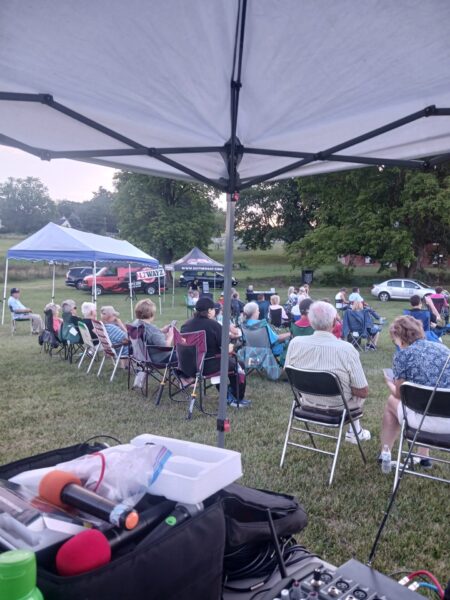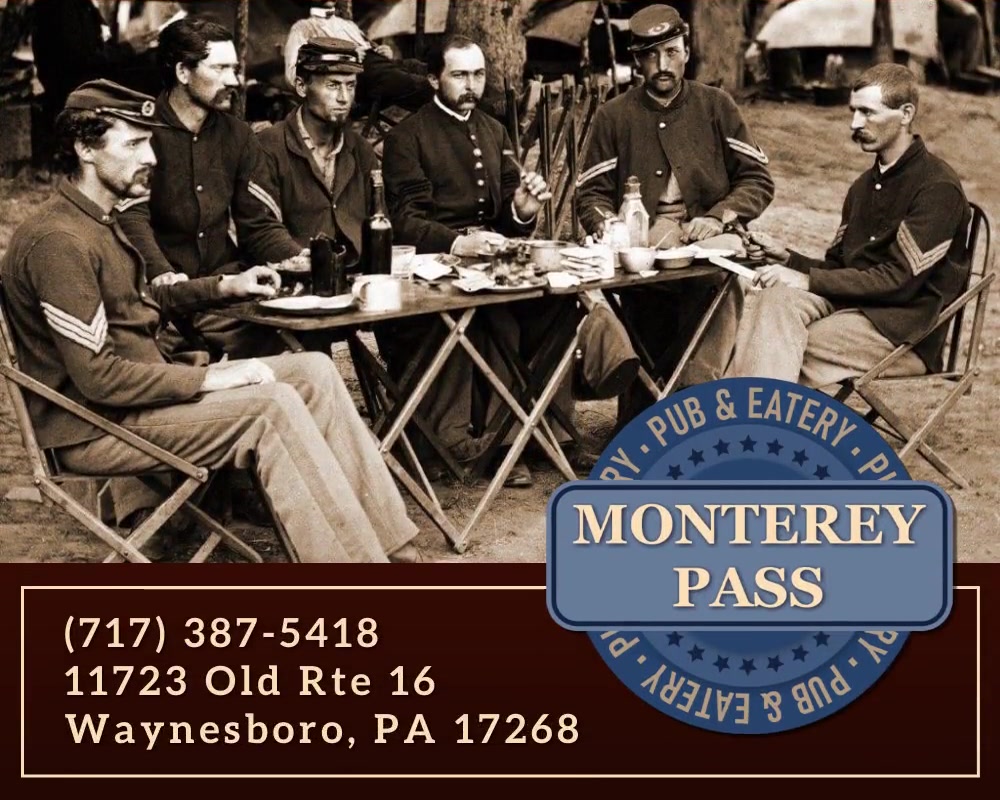Contributed from “Waynesboro – During the Civil War”, edited by Todd A. Dorsett of the Antietam Historical Association, 2011.
Preface:
This week’s Local History concerns a controversy about Gen Robert E. Lee’s path during the retreat from Gettysburg. The battle itself raged for three days. On the evening of July 4, 1863, Lee ordered the retreat of his remaining 50,000 troops generally along two paths. One, the larger, headed almost due west toward Chambersburg along what would now be Route 30 and eventually turned south toward Williamsport MD. The second went through Monterey Pass and from there along the Emmitsburg and Waynesboro Turnpike with the same ultimate destination. It took days for this mass of men and wagons, filled with equipment and supplies, to pass. There was one man, Lee himself, many wanted to see. The first two following articles on successive days from 1909 set the stage for the controversary. A contemporary historian cites references not available to the writers in 1909. The editor was satisfied.
~ ~ ~ ~ ~
The Lee Question Answered
. . . To our satisfaction . . .
WHEN LEE WENT THROUGH TOWN.
Incident of His Retreat from Gettysburg Recalled by Old Residents—Halted Here Awhile.
[The following article appeared in the Waynesboro Record, direct descendant of Editor Blair’s Village Record, June 9, 1909.]
The passing of the battalions of artillery over the line of retreat of one of Lee’s army divisions, Thursday, recalls to the minds of many of the older citizens of Waynesboro the retreat of another division through Main street after the bloody battle of Gettysburg. The army crossed the mountain from Gettysburg and one division retreated south through Midvale and Ringgold, while the other came through Waynesboro.
Sunday morning, July 5, 1863, just after the close of that decisive battle, the tired and weary troops of the confederate army began to file through the town. From then on there was a continuous stream of soldiers pouring through Main street until the following Tuesday noon.
Many remember little incidents that occurred while the army marched through.
It is recollected that General Robert E. Lee, commander in chief of the confederates, on reaching town called a halt and rested on East Main street, near the property now [1909] owned by W. J. C. Jacobs [Mountain Valley Realty, 2011]. Afterward he and his staff watered their horses on the public square and remained here about half an hour. When the halt was called, the footsore infantrymen dashed toward the pavements, in order to find cool and shady places to rest themselves.
As the rear guard of the army approached the town, the residents, who were lined along the curb stones, could distinguish the strains of “Hail Columbia” mingled with those of the confederates’ “Maryland, My Maryland.” None could account for the unusual incident but upon investigation it was found that the retreating army carried with it about a thousand union prisoners. As they neared the center of the town the captured men struck up the “StarSpangled Banner.” The citizens of Waynesboro, sympathizing with
the prisoners and loyal to their flag, joined in the song and drowned out the rebels singing their familiar tune, “Dixie.”
Tuesday noon, the last of Lee’s troops passed through the town.
One hour later the advance guard of the union army was sighted. The soldiers went through Main street in double quick time in hopes of overtaking and capturing the rebel rear guard. The lines of mounted men stretched clear across the street from curb to curb.
At center square in front of the Bowdin [sic] hotel now [1909] The Werner [Centre Square office of M&T Bank, 2011], one of the town residents, Samuel Clark by name, dashed out in front of the horsemen, waving his hat in expression of his joy at seeing the union soldiers. Before he was aware, he was hurled to the ground by the horses. No effort was made by the troops to aid the fallen man but the entire company dashed on. When the two thousand steeds had passed by, the anxious citizens expected to see the man trampled to death but to their utter surprise, every horse had jumped across his prone body and he arose uninjured.
After the rebel army had retreated, General Kilpatrick commanding a division of union men, followed over the Midvale Ringgold route. General Kilpatrick had captured Lee’s wagon train and between Midvale and Ringgold he skirmished with the confederates. It was in the evening and residents of town gathered along the “Green” alley, now [1909] alley No. 2 east [Walnut street, 2011]. The alley ran the whole length of the town and the Geiser shops were not then built on the spot. While the citizens were watching the smoke of the skirmish, a squad of cavalry rushed into town. To their amazement, the interested onlookers learned that the artillery with Kilpatrick, believing the cavalry to be a company of the enemy, had trained the cannon upon them and were ready to fire at a given signal. The scouting squad ordered the gathering to disperse, if they valued their lives, which the innocent residents did without delay.
J. F. Kurtz, North Potomac avenue, lost his boots during the confederate retreat. He owned a drug store in the room at the public square now [1909] occupied by Foreman’s shoe store. This was plundered by the retreating confederates until a guard was placed there by confederate officers.
Mr. Kurtz walked from McConnellsburg to Waynesboro, during the closing hours of Gettysburg’s battle and when he had polished his boots he took a seat with some friends in front of a building near the square. A confederate soldier admired the well polished boots and asked for them. Mr. Kurtz refused to give them up and after a little argument the soldier threatened him with his musket. Still Mr. Kurtz would not give up his boots and finally told the soldier that if he wanted them he’d have to pull them off his feet, as he (Mr. Kurtz) would not remove them. The soldier handed his musket to a comrade, and quickly pulled Mr. Kurtz’s boots from his feet. Then he passed on and Mr. Kurtz went to get other footgear.
– – – – –
DID LEE PASS THIS WAY?
Story That Is At Variance With Story Printed In These Columns Yesterday.
[The Gettysburg Semicentennial brought a resurgence of interest in incidents of the War. On July 1, 1913, the Waynesboro Daily Record printed the story about General Lee in town. In response, a reader or readers challenged the assertion that Lee retreated through Waynesboro, as the following article, from the Daily Record, July 2, 1913, attests.]
Did General Lee pass through Waynesboro on his retreat from Gettysburg? THE RECORD, yesterday, said that he did and said it on the authority of three people who say they saw the great confederate leader. It is informed, by very good authority, that Lee did not come to Waynesboro but went south by
way of Rouzerville and Ringgold. This version of the movements of General Lee after the battle of Gettysburg is based on the assertion of a confederate officer, one of several who found a temporary lodging place in an East Main street residence immediately after the end of the three day struggle.
The members of the family, in whose house he was, were anxious to see the southern army leader and made known their wish to the officer. He promised he would point out General Lee when he passed through. It was with a disappointed air that he went to the women of the family and made the announcement:
“I am very sorry but you will not see General Lee. He went south via Waterloo.”
This story has been a heritage in one of Waynesboro’s best known families since the war.
The difference in the various statements is sufficient, of course, to provoke argument but there would be nothing gained by a resort to it as it would be exceedingly difficult— perhaps impossible—to find any one to act as a competent referee.
– – – – –
LEE PASSED THIS WAY.
A Civil War Historian Gives His Professional Opinion.
WISHING to put to rest the debate whether General Lee retreated through Waynesboro following the Battle of Gettysburg, Antietam Historical Association sought the opinion of Mr. John A. Miller, park historian and education coordinator at South Mountain State Battlefield and Washington Monument State Park in Maryland.
Mr. Miller, who is also a resident of Waynesboro, kindly obliged the Association with a professional opinion. He succinctly states, “Lee did go through Waynesboro. The bulk of the Confederate army came through Waynesboro.”
In support of his opinion, Mr. Miller quotes Major John Warwick Daniel (1842–1910), who served on the staff of Major General Jubal A. Early during the Gettysburg Campaign: “Lee had a temporary headquarters along the banks of the Antietam Creek along the Emmitsburg and Waynesboro Turnpike just before entering Waynesboro” (See “The Rear Guard,” Daniel Papers, Alderman Library, University of Virginia).
Mr. Miller also offers statements made by Jedediah Hotchkiss (1828–1899), the most celebrated cartographer of the War, who mentioned Lee’s going through Waynesboro. Like Major Daniel, Hotchkiss served on the staff of General Early during the Gettysburg Campaign, but he was often detailed to work directly for General Lee at his headquarters. Following the surrender at Appomattox, General Ulysses S. Grant set Hotchkiss free, returned his valuable maps to him, and asked permission to use some of them in his official reports.
Our professional therefore concludes that it is undeniable that General Lee came through Waynesboro. The specific incidents which allegedly occurred in Centre square and the first block of East Main street involving Lee, however, remain to be verified.
The anecdote most often relied upon as proof that General Lee paused at the town pump in the Square is that George W. Davis (father of the late Clayton H. Davis, among others), a Waynesboro resident who had served under Lee in the Mexican War, recognized the great general on the Square. He then approached Lee in friendship. Upon Lee’s likewise recognizing Davis as one of his former soldiers, the
two men shook hands and parted as old friends (See Fifteen Days Under the Confederate Flag, n. p., 1963).
~ ~ ~ ~ ~ If you know of local history you would like to share, LocalNews1.org invites you to send your stories to [email protected].























